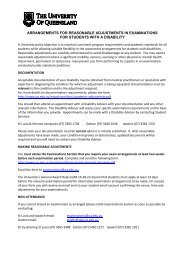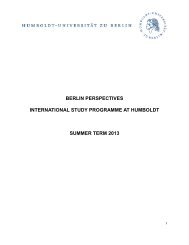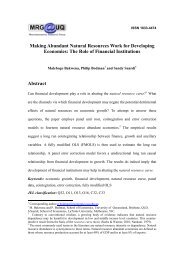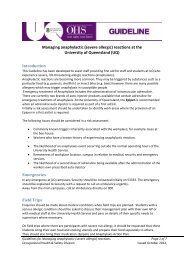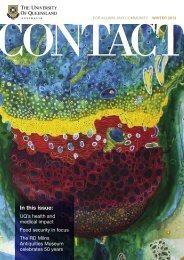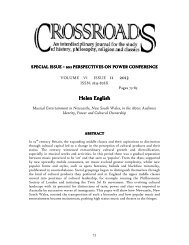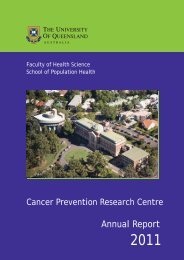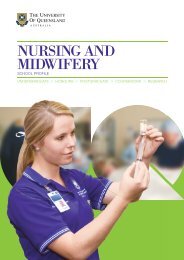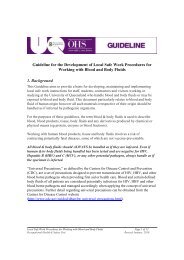Review of the Social Capital Literature - University of Queensland
Review of the Social Capital Literature - University of Queensland
Review of the Social Capital Literature - University of Queensland
You also want an ePaper? Increase the reach of your titles
YUMPU automatically turns print PDFs into web optimized ePapers that Google loves.
cooperation. <strong>Social</strong> trust, as opposed to personal trust, arises from two relatedsources; norms <strong>of</strong> reciprocity and networks <strong>of</strong> civic engagement.Norms <strong>of</strong> reciprocity can be <strong>of</strong> two sorts. Balanced reciprocity involvessimultaneous exchanges and leaves no outstanding debt. Generalised reciprocityrefers to a continuing exchange relationship that at any point in time will beunbalanced, and consequently <strong>the</strong> relationship involves mutual expectations forfuture repayment. Putnam argues that it is <strong>the</strong> norm <strong>of</strong> generalised reciprocitythat is <strong>the</strong> highly productive component <strong>of</strong> social capital, and that it is most likelyto be associated with dense networks <strong>of</strong> social exchange.Networks <strong>of</strong> civic engagement are an essential form <strong>of</strong> social capital, and <strong>the</strong>denser <strong>the</strong> networks, <strong>the</strong> greater <strong>the</strong> likelihood <strong>of</strong> cooperation for mutual benefit.Putnam notes <strong>the</strong> importance <strong>of</strong> kinship bonds but believes networks <strong>of</strong> civicengagement to be more so, as <strong>the</strong>y instigate wider cooperation. One factor thathas been disputed is Putnam’s belief that networks built around horizontal linksform <strong>the</strong> key to social capital formation, and that ‘a vertical network, no matterhow dense and no matter how important to its participants, cannot sustain socialtrust and cooperation’ (Putnam 1993:174). This narrow definition <strong>of</strong> social capitalhas been contested by some subsequent <strong>the</strong>orists, who argue that vertical tiesalso form an important source <strong>of</strong> social capital (Woolcock 2000). Putnam’sdefinition is also distinct in that he regards it as developing over a long period <strong>of</strong>time, hundreds <strong>of</strong> years in <strong>the</strong> case <strong>of</strong> Italy. This raises questions about <strong>the</strong>attempts to build social capital that have surfaced recently.2.4 Towards a Definition for GoodnaThe above definitions <strong>of</strong> social capital converge in several ways, and commoncomponents can be identified. Winter has argued that <strong>the</strong>re are many overlapsbetween <strong>the</strong> definitions <strong>of</strong> Bourdieu, Coleman and Putnam and that all ‘effectivelyrefer to <strong>the</strong> same processes’ (Winter 2000). Despite this, subsequent debate hasresulted in <strong>the</strong> development <strong>of</strong> countless alternative definitions, among whichconfusion is rife. There is a danger that some authors have failed to distinguishbetween what social capital is and what it does, <strong>the</strong> sources from <strong>the</strong>consequences (Woolcock 1998), and as a result discussions <strong>of</strong> social capital<strong>of</strong>ten fail to refer to <strong>the</strong> same thing.Among <strong>the</strong>se definitions however it has been argued that consensus is emerging,summarised as follows: ‘social capital refers to <strong>the</strong> norms and networks thatfacilitate collective action’ (Woolcock 2001). O<strong>the</strong>r points <strong>of</strong> general agreementcan be found. <strong>Social</strong> capital is widely regarded as a resource that is productive(hence <strong>the</strong> applicability <strong>of</strong> ‘capital’). In addition to it’s role in facilitatingcooperation and action, social capital can act as a form <strong>of</strong> social control, forexample in <strong>the</strong> form <strong>of</strong> sanctions (Wall, Ferrazzi et al. 1998). The public goodaspect <strong>of</strong> social capital is also widely acknowledged, recognising that socialFebruary 2001 DRAFT ONLY 6
capital belongs to no one individual but is an inherent feature <strong>of</strong> <strong>the</strong> socialstructure.Away from <strong>the</strong>se few points <strong>of</strong> agreement however are major points <strong>of</strong>contention, reflected in <strong>the</strong> differing definitions and applications <strong>of</strong> <strong>the</strong> concept.These include:1. The appropriate level <strong>of</strong> analysisThis particular aspect is cause for division among current research onsocial capital. While Bourdieu and Coleman include analysis at <strong>the</strong> level <strong>of</strong><strong>the</strong> individual Putnam broadens this to a regional level, a schism reflectedin subsequent thinking. Some talk <strong>of</strong> individual social capital while o<strong>the</strong>rsstrongly argue that social capital is a feature <strong>of</strong> <strong>the</strong> collective, which should<strong>the</strong>refore be measured at <strong>the</strong> community level (Kawachi 1999), (Cox1997).For <strong>the</strong> purposes <strong>of</strong> Goodna, <strong>the</strong> idea <strong>of</strong> social capital as a communitylevel variable could be regarded as it’s distinctive feature, <strong>the</strong> valueadded.Ra<strong>the</strong>r than <strong>the</strong> idea <strong>of</strong> individual social capital, referring toindividual stocks <strong>of</strong> social capital, perhaps this can best be thought <strong>of</strong> interms <strong>of</strong> differential access that individuals have to <strong>the</strong> reserve <strong>of</strong>community social capital.2. Various forms <strong>of</strong> social capitalNumerous different forms <strong>of</strong> social capital have been identified, several <strong>of</strong>which recur throughout <strong>the</strong> literature. These different forms can be thought<strong>of</strong> as being ei<strong>the</strong>r cognitive or structural (Krishna and Shrader 2000).Cognitive forms include norms, values, attitudes and beliefs, whilestructural forms relate to networks, roles, rules and precedents (Krishnaand Shrader 2000). Both <strong>of</strong> <strong>the</strong>se dimensions are important, and need tobe taken into account in any assessment <strong>of</strong> social capital in a community.There is variation in terms <strong>of</strong> what are regarded to be forms <strong>of</strong> socialcapital. There is also confusion as what may be called forms by one maybe referred to as components by ano<strong>the</strong>r, despite <strong>the</strong> difference between<strong>the</strong>m.3. The differing dimensions <strong>of</strong> social capitalWhile widely accepted that networks are an integral form <strong>of</strong> social capital,debate exists over which type to include. Putnam strongly asserts that onlyhorizontal networks should be considered, yet subsequent <strong>the</strong>orisingincludes both horizontal and vertical, leading to <strong>the</strong> identification <strong>of</strong>different dimensions <strong>of</strong> social capital:February 2001 DRAFT ONLY 7
? Bridging social capital – consisting <strong>of</strong> strong ties within a horizontalnetwork, including family, close friends, neighbours, colleagues etc? Bonding social capital – weaker ties also, with individuals sharingsimilar economic and political position, but who differ in terms <strong>of</strong>location, occupation, or ethnic group.? Linking social capital – vertical ties with formal institutions andorganizations (Woolcock 2000).4. The role <strong>of</strong> trustTrust is regarded as central in most explanations <strong>of</strong> social capital, butopinion on its precise role differs. Some see trust as a form <strong>of</strong> socialcapital, o<strong>the</strong>rs regard it as <strong>the</strong> ‘currency <strong>of</strong> social capital’ (Cox 1997), whileyet o<strong>the</strong>rs see it as a component <strong>of</strong> social capital (Glaeser, Laibson et al.2000). This both reflects and adds to <strong>the</strong> confusion; any definition forGoodna must be clear in terms <strong>of</strong> <strong>the</strong> role <strong>of</strong> trust.While not wishing to become engulfed in <strong>the</strong> numerous debates, a cleardefinition is required for <strong>the</strong> Goodna project as measurement will be problematicwithout one. Some <strong>of</strong> <strong>the</strong> more common aspects coming out <strong>of</strong> <strong>the</strong> literaturecould be drawn upon to form a working definition. This should be debated as torelevance and importance, and <strong>the</strong> above points <strong>of</strong> contention considered, toensure an appropriate definition is developed for <strong>the</strong> Goodna context.3 Measuring social capitalAs social capital cannot be assessed directly, it has to be operationalised intoindicators. Indicators used to measure social capital depend on two things; <strong>the</strong>definition <strong>of</strong> social capital and <strong>the</strong> context within which measurement occurs.Once indicators have been identified <strong>the</strong>y can be measured ei<strong>the</strong>r by utilisingexisting, usually statistical data or by tools designed to generate primary data.The lack <strong>of</strong> a single clear definition has resulted in <strong>the</strong> development <strong>of</strong> a number<strong>of</strong> indicators which ‘tap slightly different – but also substantially overlapping –characteristics <strong>of</strong> social relations at <strong>the</strong> community level’ (Lochner, Kawachi et al.1999). As a result, ‘measurement consists <strong>of</strong> unsystematic bits and pieces <strong>of</strong>evidence from many sources using different definitions, and from studies usingdifferent macro-proxies’ (Paldam and Svendsen 1999).Generally speaking, <strong>the</strong> literature on measuring social capital falls into threecategories:1. Theoretical discussions concerning measurement, including attempts todevise measurement tools;February 2001 DRAFT ONLY 8
2. Empirical testing <strong>of</strong> measurement tools;3. Research into associations between social capital and o<strong>the</strong>r variables, inwhich measurement occurs as an integral part <strong>of</strong> <strong>the</strong> research but is not<strong>the</strong> primary objective.This review focuses upon <strong>the</strong> variety <strong>of</strong> ways in which social capital has beenmeasured, regardless <strong>of</strong> <strong>the</strong> definition used. In particular, it looks at <strong>the</strong> empiricalattempts to measure social capital identified in categories 2 and 3 above. Some<strong>of</strong> <strong>the</strong> more common indicators are highlighted first, toge<strong>the</strong>r with issues andcriticisms that have been raised in <strong>the</strong>ir regard, before looking at tools developedspecifically to measure social capital. 33.1 Indicators <strong>of</strong> <strong>Social</strong> <strong>Capital</strong>Indicators identified by Coleman and Putnam have been widely drawn upon,Coleman’s initial interest was <strong>the</strong> role <strong>of</strong> social capital in <strong>the</strong> formation <strong>of</strong> humancapital, and his research focused upon <strong>the</strong> effect <strong>of</strong> lack <strong>of</strong> social capital onchildren dropping out <strong>of</strong> school. <strong>Social</strong> capital in this context was operationalisedusing <strong>the</strong> following indicators:? <strong>the</strong> parents’ presence in <strong>the</strong> home (two parents or a single parent)? <strong>the</strong> number <strong>of</strong> additional children present? <strong>the</strong> different combinations <strong>of</strong> parents and siblings? <strong>the</strong> mo<strong>the</strong>r’s expectation for a child’s education? <strong>the</strong> mobility <strong>of</strong> <strong>the</strong> family? church attendanceColeman’s use <strong>of</strong> <strong>the</strong> above indicators reflects his specific interest in <strong>the</strong> role <strong>of</strong>family social capital. These micro-level indicators would need to be combinedwith o<strong>the</strong>r indicators, or <strong>the</strong> results aggregated to be <strong>of</strong> benefit at <strong>the</strong> communitylevel. This is perhaps one <strong>of</strong> <strong>the</strong> reasons that it is Putnam’s macro-levelmeasures that have been adopted in many cases. Putnam indicators included:? participation in voluntary associations (including amateur soccer clubs,choral societies, hiking clubs, bird-watching groups and literary circles)? newspaper readership? voting patterns – electoral turnout and preference voting (Putnam,Leonardi et al. 1993)Putnam’s measure <strong>of</strong> voluntary association has been used many timessubsequently, although criticisms have been levelled at it (see below).Subsequent alternative indicators have also been developed, as will be3The main indicators and measures <strong>of</strong> social capital are summarised in Appendix 1.February 2001 DRAFT ONLY 9
highlighted in section 4, but many <strong>of</strong> <strong>the</strong>se show an obvious debt to <strong>the</strong> work <strong>of</strong>Coleman or Putnam.3.1.1 Problems with Indicators and Their MeasurementMuch social capital research has relied upon existing statistical data sets, whichcan lead to a number <strong>of</strong> problems;? Data may not exist for certain indicators, leading to <strong>the</strong>ir omittance oronly partial measurement. One example <strong>of</strong> this is trust, widely regardedto be a central component <strong>of</strong> social capital. Trust has been measuredusing just one or two items from <strong>the</strong> General <strong>Social</strong> Survey, conductedin <strong>the</strong> US (see 3.2.3 below for details).? Existing data sets that have not been specifically designed to measuresocial capital indicators, and may not capture particular aspects.Coleman noted in his research that his results would have been moresatisfactory ‘if <strong>the</strong> research had been explicitly designed to examineeffects <strong>of</strong> social capital within <strong>the</strong> family’ (Coleman 1988), ra<strong>the</strong>r thanrelying on <strong>the</strong> ‘High School and Beyond’ dataset. However he believed<strong>the</strong> results were still sufficient to indicate <strong>the</strong> importance <strong>of</strong> socialcapital, a belief that appears to have been adopted by subsequent<strong>the</strong>orists who have also used existing datasets.Aside from measurement difficulties, <strong>the</strong> use <strong>of</strong> indicators has been criticisedin o<strong>the</strong>r ways;? Indicators focus upon quantitative measurement which means that <strong>the</strong>quality <strong>of</strong> relationships, key to building trust and obligations, tends tobe overlooked (Wall, Ferrazzi et al. 1998). This has led to <strong>the</strong>development <strong>of</strong> a number <strong>of</strong> alternative measurement tools, whichcombine quantitative and qualitative methods to capture alldimensions.? The final confusion that arises in connection with measuring socialcapital relates to <strong>the</strong> level at which it is measured. A widely regardeddistinctive feature <strong>of</strong> social capital is that it should be measured at <strong>the</strong>level <strong>of</strong> <strong>the</strong> community, <strong>the</strong> ecologic level.Additionally, a number <strong>of</strong> criticisms have been levelled at Putnam’s use <strong>of</strong>membership in voluntary associations, a measure has been frequently used in<strong>the</strong> assessment <strong>of</strong> social capital (see for example Paldam and Svendsen 1999).Fukuyama (Fukuyama 1997) argues that this indicator, measured bymembership data, is flawed in that it only picks up membership in organisationsformal enough to maintain membership data. Many social groups and networksare informal and consequently <strong>the</strong>ir existence, and individuals’ participation inFebruary 2001 DRAFT ONLY 10
<strong>the</strong>m would not be acknowledged using Putnam’s method. Fukuyama alsohighlights o<strong>the</strong>r measurement problems associated with this indicator- The positive and negative externalities <strong>of</strong> group membership. Theformer refers to <strong>the</strong> fact that some groups build social capital withmembers outside <strong>the</strong>ir group, while o<strong>the</strong>rs share this with only groupmembers, and sometimes not even with <strong>the</strong>m. Members <strong>of</strong> largeorganisations are no more likely to cooperate with each o<strong>the</strong>r simplybecause <strong>the</strong>y pay membership fees to <strong>the</strong> same body. Negativeexternalities refer to those groups that actively promote hatred andintolerance, and <strong>the</strong>refore share norms at odds with <strong>the</strong> rest <strong>of</strong> society.- <strong>Social</strong> capital has an important qualitative dimension that cannot bereflected in membership data, and it is necessary to know just howcohesive <strong>the</strong> group is, not just that it exists.In light <strong>of</strong> <strong>the</strong> above, <strong>the</strong>re is much to be taken into account when identifyingindicators and data sources. Reliance upon statistical data may only provide aguide to <strong>the</strong> existence <strong>of</strong> social capital, without determining more qualitativeaspects. This has proved sufficient for a number <strong>of</strong> authors (see for exampleTeachman, Paasch et al. 1996, Sun 1999, Lichter, Gretchen et al. 1993, as itavoids primary research. However <strong>the</strong> validity <strong>of</strong> findings is likely to be less thanthose <strong>of</strong> an approach that attempts to measure both dimensions <strong>of</strong> social capital.These are outlined below.3.2 <strong>Social</strong> <strong>Capital</strong> Measurement ToolsAttempts to empirically measure social capital using specially-designed toolshave appeared recently. These tools, which usually take <strong>the</strong> format <strong>of</strong> aninterview or questionnaire, generate quantitative and/or qualitative dataspecifically designed at measuring social capital, and as a result may providemore reliable results.3.2.1 Measurement <strong>of</strong> <strong>Social</strong> <strong>Capital</strong> in New South WalesOnyx and Bullen (Onyx and Bullen 2000), (Onyx and Bullen 1997), (Bullen andOnyx 1998) identified potential items to measure what <strong>the</strong>y consider to be <strong>the</strong>core elements <strong>of</strong> social capital: participation in networks, reciprocity, trust, socialnorms, <strong>the</strong> commons (shared community resources) and social agency. Aquestionnaire designed to tap into each <strong>of</strong> <strong>the</strong> dimensions <strong>of</strong> social capital wasdeveloped, containing 68 potential social capital items. The final version includedseveral elements to tap each <strong>of</strong> <strong>the</strong> dimensions <strong>of</strong> attitudes (value <strong>of</strong> self);trust/perceived safety; participation in <strong>the</strong> local community; reciprocity; personalempowerment; diversity/openness; relations within <strong>the</strong> workplace; attitudes togovernment and demographic information.February 2001 DRAFT ONLY 11
The questionnaire was administered to a sample <strong>of</strong> 1211 citizens living in urbanand rural NSW. While this was not representative in <strong>the</strong> strict sense <strong>of</strong> <strong>the</strong> term, itdid apparently represent a broad cross-section <strong>of</strong> adults living and working inNSW in 1997. Results showed that social capital is an empirical concept, which ispossible to measure in local communities. Analysis <strong>of</strong> data revealed a genericsocial capital factor that can be measured, as well as eight distinct elements thattoge<strong>the</strong>r appear to define social capital. These eight factors are communityparticipation, agency, trust, workplace, neighbours, tolerance, friends and value<strong>of</strong> life, <strong>the</strong> first three <strong>of</strong> which are very strong. Fur<strong>the</strong>r analysis suggests that<strong>the</strong>re is some relationship between <strong>the</strong> separate factors, though this is strongerfor some factors ra<strong>the</strong>r than o<strong>the</strong>rs.Their analysis also showed strong differences in <strong>the</strong> level and pattern <strong>of</strong>responses to social capital across different communities. In general, it appearsthat social capital is higher in rural compared with urban areas in relation tocertain factors, namely community, trust and connections; however, metropolitanareas scored higher in terms <strong>of</strong> agency and tolerance <strong>of</strong> diversity. Onyx believesthis pattern suggests that rural communities generate considerable bondingsocial capital, largely limited to insiders, while urban areas may show greatertolerance and individual initiative, suggesting weaker ties, or bridging socialcapital (Onyx and Bullen 2000). This difference between rural and urbancommunities has also been examined in relation to education, as outlined insection 4.1 below.3.2.2 <strong>Social</strong> <strong>Capital</strong> Assessment Tool (SCAT)Remarking upon <strong>the</strong> diversity <strong>of</strong> existing measurement tools, Krishna andShrader develop a methodological tool for <strong>the</strong> operationalisation <strong>of</strong> social capital,as a first step towards <strong>the</strong> development <strong>of</strong> a uniform measure <strong>of</strong> micro-levelsocial capital (Krishna and Shrader 2000). They make a useful distinctionbetween cognitive elements <strong>of</strong> social capital (values, norms, trust and beliefs)and structural elements (networks, rules, roles and precedents), both <strong>of</strong> whichcan facilitate voluntary cooperation. As this is <strong>the</strong> case, it is necessary to takeboth dimensions into account when designing a measurement tool. It is alsoimportant to have knowledge <strong>of</strong> <strong>the</strong> context under examination, to ensure a clearunderstanding <strong>of</strong> <strong>the</strong> separate norms and networks that exist.The SCAT is designed to measure micro -level social capital at <strong>the</strong> level <strong>of</strong>communities and households. Favouring a combination <strong>of</strong> both quantitative andqualitative methods, <strong>the</strong> tool has three components, which can be appliedseparately, sequentially or simultaneously:1. The community pr<strong>of</strong>ile – aims to identify features associated with socialcapital in <strong>the</strong> particular cultural and institutional setting, and integratesparticipatory qualitative methods with a community survey instrument. Itserves three main objectives:February 2001 DRAFT ONLY 12
? Familiarises researchers with <strong>the</strong> community? Open discussion with community members allows <strong>the</strong>m to learn about<strong>the</strong> activities <strong>of</strong> <strong>the</strong> research team? Generate preliminary sources <strong>of</strong> information on institutions andrelations within <strong>the</strong> community2. The household survey – contains 39 close-ended items relating to <strong>the</strong>structural dimensions <strong>of</strong> social capital, and 21 close-ended items relatingto <strong>the</strong> cognitive dimensions. It’s primary objectives are? To generate quantified indicators <strong>of</strong> social capital, measuringhousehold stocks <strong>of</strong> and access to social capital? To aggregate <strong>the</strong>se figures appropriately to generate community levelmeasures <strong>of</strong> social capital3. Organizational pr<strong>of</strong>ile - aims to delineate <strong>the</strong> relationships and networksthat exist among formal and informal institutions, and integrates semistructuredinterview data with a scoring system for assessingorganizational capacity and sustainability.The SCAT was tested in Panama and India, and overall was found to be valuablefor? Assessing and scaling social capital? Identifying some local organizational capacitiesThe versatility <strong>of</strong> SCAT methods allows its adaptation to a wide variety <strong>of</strong>research and development contexts. It is a comprehensive tool that, by utilising anumber <strong>of</strong> different methods, has <strong>the</strong> potential for effectiveness at <strong>the</strong> communitylevel. It’s comprehensiveness however, is likely to make any application <strong>of</strong> <strong>the</strong>SCAT a large-scale, and hence costly research exercise.3.2.3 Measurement <strong>of</strong> <strong>Social</strong> <strong>Capital</strong> Components - TrustWhile trust has been measured in a number <strong>of</strong> ways within <strong>the</strong> psychologicalliterature, more specific measures have also been developed to measure trust asa component <strong>of</strong> social capital. Trust has been defined in multiple ways, althoughwithin <strong>the</strong> social capital literature trust is more frequently used to refer to ageneralised trust among individuals or trust people have in institutions. A number<strong>of</strong> general trust scales have been developed. These include <strong>the</strong> Trust Inventory(Couch, Adams et al. 1996), a 40-item questionnaire developed by drawing upona number <strong>of</strong> previous trust scales, which is designed to measure generalised,network and relational (or partner) trust. Ano<strong>the</strong>r is <strong>the</strong> Interpersonal Mistrust-Trust Measure (IMTM) (Omodei and McLennan 2000), which measuresinterpersonal trust as a negative orientation against o<strong>the</strong>rs, a tendency to viewFebruary 2001 DRAFT ONLY 13
o<strong>the</strong>rs as mean, selfish or unreliable. This measure consists <strong>of</strong> items describingperceptions <strong>of</strong> specific hypo<strong>the</strong>tical interpersonal situations, ra<strong>the</strong>r than askingrespondents to describe <strong>the</strong>ir own general behaviour.Among <strong>the</strong> more specific social capital measures <strong>of</strong> trust a common approachhas been to utilise GSS survey data. Various studies have used data relating to<strong>the</strong> questions in this survey relating to trust, in attempts to obtain a generalisedview <strong>of</strong> <strong>the</strong> general climate <strong>of</strong> trust in a community. The two items mostfrequently used are‘Generally speaking, would you say that most people can be trusted, or that youcan’t be too careful in dealing with people?’‘Do you think most people would try to take advantage <strong>of</strong> you if <strong>the</strong>y got achance, or would <strong>the</strong>y try to be fair?’Examples <strong>of</strong> research using this measure <strong>of</strong> trust include Kawachi, Kennedy etal. (1997) and Kennedy, Kawachi et al. (1998) (see section 4 below).Ano<strong>the</strong>r specific attempt to measure trust as a component <strong>of</strong> social capital hasbeen to use an experimental method. Glaeser et al attempt to do this byconducting experiments with monetary awards in order to measure trust andtrustworthiness (Glaeser, Laibson et al. 2000).Survey questions were asked <strong>of</strong> a sample <strong>of</strong> Harvard undergraduates, coveringdemographic and behavioural questions, as well as attitudinal and self-reportedbehavioural measures <strong>of</strong> subjects’ trustfulness and trustworthiness. This wasfollowed by participation in two ‘trust’ games. The first experimental trust gameinvolves subjects working in pairs. The first subject is given <strong>the</strong> opportunity tosend <strong>the</strong>ir partner an amount <strong>of</strong> money between 0 and 15 dollars. This chosenamount is doubled by <strong>the</strong> experimenter, and given to <strong>the</strong> second player. Thesecond player may <strong>the</strong>n return money back to <strong>the</strong> first player. Glaeser et albelieve that <strong>the</strong> amount sent by <strong>the</strong> sender is a na tural measure <strong>of</strong> trust, as <strong>the</strong>sender trusts <strong>the</strong> recipient to return a fair share <strong>of</strong> <strong>the</strong> amount sent. They alsobelieve that, controlling for <strong>the</strong> amount sent, <strong>the</strong> amount returned is a measure <strong>of</strong>trustworthiness.In <strong>the</strong> second experimental game, subjects report valuations for a series <strong>of</strong>‘envelope drops’. Envelopes, containing $10 and addressed to <strong>the</strong> subjects, willbe dropped by <strong>the</strong> experimenters in different public places and under differentconditions. For each place and condition <strong>the</strong> subject reports a valuation. If a highvalue is placed on <strong>the</strong> dropped envelopes, <strong>the</strong> researchers inferred that <strong>the</strong>subject was more likely to trust strangers to return <strong>the</strong> envelopes.The results showed that standard attitudinal survey questions about trust predicttrustworthy behaviour in <strong>the</strong> experiments much better than <strong>the</strong>y predicted trustingFebruary 2001 DRAFT ONLY 14
ehaviour. Trusting behaviour in <strong>the</strong> experiments is predicted by past trustingbehaviour outside <strong>of</strong> <strong>the</strong> experiments. <strong>Social</strong> connection strongly predictstrustworthiness and weakly predicts trust. It was also determined that high statusindividuals are able to elicit more trustworthiness in o<strong>the</strong>rs. Glaeser suggests <strong>the</strong>existence <strong>of</strong> ‘individual social capital’, a subcomponent <strong>of</strong> human capital thatreflects an ability to earn returns from social situations.3.2.4 Measurement <strong>of</strong> <strong>Social</strong> <strong>Capital</strong> Components – Well-beingAno<strong>the</strong>r potential tool for <strong>the</strong> measurement <strong>of</strong> social capital, community socialauditing, is currently being developed by Eva Cox and colleagues (Cox 1998). Amanual will act as a guide for implementing social capital audits based oncommunity, and will involve looking at various components including trust,obligation, organisational norms and values and <strong>the</strong> effects <strong>of</strong> inequality onperceptions and attitudes. The identified items will be a mix <strong>of</strong> existing data,people's expressed attitudes, fears and anxieties, <strong>the</strong>ir actions and activities, withany o<strong>the</strong>r relevant observations or o<strong>the</strong>r ways <strong>of</strong> representing views. Includedwould be aspects <strong>of</strong> family and households as well as workplace, and publicspace activities and observations. The data collections would be framed within<strong>the</strong> traditions and rituals <strong>of</strong> <strong>the</strong> community. While fur<strong>the</strong>r details are not yetavailable, it seems likely that this method could provide a feasible framework forassessing <strong>the</strong> state <strong>of</strong> social capital in Goodna.3.2.5 Implications for <strong>the</strong> Goodna ProjectThis section has highlighted some <strong>of</strong> <strong>the</strong> indicators and tools that have beenempirically tested in <strong>the</strong> measurement <strong>of</strong> social capital. The major differencerelates to <strong>the</strong> sources <strong>of</strong> data used. Indicators relying upon existing statisticaldata can yield results, but <strong>the</strong> validity and reliability <strong>of</strong> such results may bequestionable. Measurement tools designed to generate primary data can perhapsprovide a more holistic approach to social capital measurement, but <strong>the</strong>ircomprehensive nature means that <strong>the</strong>ir undertaking is likely to be a large-scaleand costly enterprise. The review will now consider empirical attempts to assess<strong>the</strong> associations between social capital and o<strong>the</strong>r variables relevant to <strong>the</strong>Goodna project.4. <strong>Social</strong> <strong>Capital</strong> and <strong>the</strong> Goodna outcomesThe above gives an indication <strong>of</strong> ways devised and indicators used to measuresocial capital, while many more have been devised during <strong>the</strong> course <strong>of</strong> empiricalresearch into <strong>the</strong> correlations between social capital and o<strong>the</strong>r variables. Ofrelevance here are those between social capital and education, health, housingpolicy, crime, community, family and work. It should be noted that much <strong>of</strong> thisempirical work has been conducted in North America, which may haveimplications for research in o<strong>the</strong>r contexts.February 2001 DRAFT ONLY 15
4.1 <strong>Social</strong> <strong>Capital</strong> and EducationColeman regarded <strong>the</strong> effect <strong>of</strong> social capital on <strong>the</strong> creation <strong>of</strong> human capital in<strong>the</strong> next generation as being especially important. Both family social capital andsocial capital in <strong>the</strong> community contribute to this process in different ways. Familysocial capital depends on <strong>the</strong> physical presence <strong>of</strong> parents in <strong>the</strong> family, and on<strong>the</strong> attention <strong>the</strong>y give to <strong>the</strong> child. Also important is <strong>the</strong> strength <strong>of</strong> relationsbetween <strong>the</strong> parent and <strong>the</strong> child. If strong relations are lacking, <strong>the</strong>n socialcapital is missing. ‘If <strong>the</strong> human capital possessed by parents is notcomplemented by social capital embodied in family relations, it is irrelevant to <strong>the</strong>child’s educational growth that <strong>the</strong> parent has a great deal, or a small amount <strong>of</strong>human capital’ (Coleman 1988). Focusing on <strong>the</strong> effect a lack <strong>of</strong> social capitalwithin <strong>the</strong> family has upon dropping out <strong>of</strong> high school, Coleman uses a number<strong>of</strong> indicators to measure family social capital (outlined in section 3 above).Results show that <strong>the</strong> lower <strong>the</strong> amount <strong>of</strong> family social capital, <strong>the</strong> higher <strong>the</strong>dropout rate from school, demonstrating that family social capital is a resource forchildren’s education.<strong>Social</strong> capital outside <strong>the</strong> family is also <strong>of</strong> value when looking at dropping out <strong>of</strong>school. This consists <strong>of</strong> ‘<strong>the</strong> social relationships that exist among parents, in <strong>the</strong>closure exhibited by this structure <strong>of</strong> relations, and in <strong>the</strong> parents’ relations with<strong>the</strong> institutions <strong>of</strong> <strong>the</strong> community’ (Coleman 1988: S113). Using <strong>the</strong> High Schooland Beyond dataset, Coleman argues that ano<strong>the</strong>r indicator <strong>of</strong> social capital is<strong>the</strong> distinction between public high schools, religiously based private high schoolsand non-religiously based private high schools. The religiously based private highschools are surrounded by a community based on religious organisation, and byfamilies that have ‘intergenerational closure based on a multiplex relation’. Usingfrequency <strong>of</strong> attendance at religious services as a measure <strong>of</strong> social capital,Coleman’s analysis demonstrated an extremely low dropout rate in Catholicprivate schools. This could not be attributed to <strong>the</strong> religion <strong>of</strong> students, or degree<strong>of</strong> religious observance, as Catholic students in public schools are only slightlyless likely to drop out than non-Catholics (Coleman 1988: S114). The resultsprovide evidence <strong>of</strong> <strong>the</strong> importance <strong>of</strong> social capital outside <strong>the</strong> family, in <strong>the</strong>adult community <strong>of</strong> <strong>the</strong> school, for <strong>the</strong> lower dropout rates observed. Heconcludes that ‘both social capital in <strong>the</strong> family and social capital outside it, in <strong>the</strong>adult community surrounding <strong>the</strong> school, showed evidence <strong>of</strong> considerable valuein reducing <strong>the</strong> probability <strong>of</strong> dropping out <strong>of</strong> high school’ (Coleman 1988: S118-S119).After ColemanColeman’s work has been both criticised and developed, inspiring a range <strong>of</strong>research looking at different variables. Much <strong>of</strong> this later research draws upon<strong>the</strong> National Educational Longitudinal Study (NELS), a nationally representativesurvey <strong>of</strong> 8 th graders initially conducted in 1988, with follow up surveys in 1990and 1992. Generally speaking results suggest that social capital is <strong>of</strong> potentialFebruary 2001 DRAFT ONLY 16
importance, with findings suggesting correlations between higher levels <strong>of</strong> socialcapital and low levels <strong>of</strong> school drop-out, lower truancy rates and higher levels <strong>of</strong>academic achievement.4.1.1 Dropping Out <strong>of</strong> SchoolSeveral studies have added to <strong>the</strong> evidence on <strong>the</strong> correlation between highlevels <strong>of</strong> social capital and low drop-out rates. Teachman et al (1996), focusingupon family social capital, look at its effect on students who drop out between <strong>the</strong>8 th and 10 th grade. They use a number <strong>of</strong> detailed measures <strong>of</strong> social capital, andcriticise Coleman for reliance upon what <strong>the</strong>y perceive to be relatively simplemeasures (Teachman, Paasch et al. 1996: 775). These include a range <strong>of</strong>measures <strong>of</strong> family structure (series <strong>of</strong> questions concerning livingarrangements), attendance at a Catholic school, whe<strong>the</strong>r parents know <strong>the</strong>parents <strong>of</strong> children’s closest school friends, <strong>the</strong> number <strong>of</strong> times a child haschanged schools, parent-child interaction and parent-school interaction. Theresults showed that changing school was particularly detrimental in terms <strong>of</strong>dropping out <strong>of</strong> school. Interpreting <strong>the</strong>se results within a social capitalframework, Teachman et al assume that ‘changing schools reduces <strong>the</strong> ability <strong>of</strong>parents and children to make wise decisions about schooling’ (Teachman,Paasch et al. 1996: 782). Teachers may be less committed to children who havemoved, and children may feel separated from <strong>the</strong> education process.In a later study, <strong>the</strong> same authors examine whe<strong>the</strong>r social capital interacts with<strong>the</strong> human and financial capital possessed by parents to produce human capitalin children (Teachman, Paasch et al. 1997). Expanding on <strong>the</strong> measures usedpreviously, three indirect general measures <strong>of</strong> social capital are included; familystructure (for family social capital), attendance at a Catholic high school (tomeasure social capital resulting from ties with <strong>the</strong> large community, assumed tobe greater within a Catholic community), and <strong>the</strong> number <strong>of</strong> times <strong>the</strong> child haschanged schools (as this represents disruption in relations between parents,children and parents). Also included are more specific social capital measuresused previously, tapping schooling-related patterns <strong>of</strong> social relationships. Theseinclude a measure <strong>of</strong> whe<strong>the</strong>r parents know <strong>the</strong> parents <strong>of</strong> <strong>the</strong>ir child’s closestschool friends, and <strong>the</strong> intensity <strong>of</strong> schooling-related interaction between parentsand children and between parents and schools. Responses provided by studentsand parents provided data for <strong>the</strong>se measures, from which five summary indexesfor parent-child interaction and parent-school interaction were produced. Thefindings indicate that both <strong>the</strong> general and more specific measures <strong>of</strong> socialcapital are related to dropping out <strong>of</strong> high school, and also that social capitalinteracts with <strong>the</strong> financial and human capital <strong>of</strong> parents to determine schoolcontinuation.A social capital framework has also been used to assess differences in drop outrates between urban and rural areas. Working directly with Coleman’sconceptualisation <strong>of</strong> family social capital, Lichter looks at whe<strong>the</strong>r differences inFebruary 2001 DRAFT ONLY 17
ural/urban high school drop out rates can be explained by differences in familysocial capital (Lichter, Gretchen et al. 1993). Using data from <strong>the</strong> 1990 CurrentPopulation Survey, Lichter uses family structure as a component <strong>of</strong> social capital,and measures this using <strong>the</strong> indicators <strong>of</strong> current living arrangements, parentalstatus and household size. The findings suggest that poverty contributes more to<strong>the</strong> higher dropout rates among rural youth than does residential location, andwhile family structure was also found to have an effect, it was less in rural areas,possible due to some 'compensating forms <strong>of</strong> social capital found in ruralcommunities.' Lack <strong>of</strong> parental human capital was also suggested to be a likelydownward pressure on rural children's school experiences.4.1.2 Academic AchievementIn addition to drop out rates, <strong>the</strong>re has been interest in <strong>the</strong> effect <strong>of</strong> social capitalon academic achievement. Meier (Meier 1999) examines this influence on schoolachievement and <strong>the</strong> decision to remain in school or drop out. A specific focus iswhe<strong>the</strong>r social capital may cushion <strong>the</strong> negative effects <strong>of</strong> growing up with onlyone parent. Using data from <strong>the</strong> National Longitudinal Study <strong>of</strong> AdolescentHealth, Meier distinguishes between forms <strong>of</strong> social capital and benefits fromsocial capital. The former is measured using family structure and residentialmobility, while <strong>the</strong> latter uses intergenerational closure, parent-child interaction,parent-school interaction, student-teacher relationship, and extracurricular activityparticipation. An alternative conceptualisation <strong>of</strong> social capital as parentalinvolvement is made by McNeal, in assessing <strong>the</strong> influence <strong>of</strong> social capital uponcognitive (achievement) and behavioural (truancy and dropping out) outcomes(McNeal 1999). Using NELS data, <strong>the</strong> research uses <strong>the</strong> following measures <strong>of</strong>parental involvement: parent-child discussion (degree to which parents andchildren converse about education); parent involvement in <strong>the</strong> parent-teacherorganization (PTO); monitoring <strong>of</strong> behaviour; and educational support strategies(parental involvement with <strong>the</strong> educational process). Research findings indicatethat parental involvement is generally a salient factor in explaining behavioral butnot cognitive outcomes, with greatest support for parent-child discussion andinvolvement in parent-teacher organizations. Findings also indicate that <strong>the</strong>positive influences <strong>of</strong> social capital <strong>of</strong>ten persisted only for members <strong>of</strong>traditionally advantaged sectors <strong>of</strong> <strong>the</strong> population, namely more affluent andwhite students.Sun (1999) takes a community level approach in examining <strong>the</strong> contextual effects<strong>of</strong> social capital on <strong>the</strong> academic performance <strong>of</strong> all students living in <strong>the</strong>community. Drawing on <strong>the</strong> NELS data, Sun conceptualises community-basedsocial capital as being comprised <strong>of</strong> both a structural and a process component.Structural family social capital is measured using Coleman’s measures <strong>of</strong> number<strong>of</strong> siblings, non-traditional family structure and <strong>the</strong> number <strong>of</strong> school changessince 1 st grade. Process social capital is measured by an aggregate <strong>of</strong> fourindividual-level measures <strong>of</strong> parent/student participation in community activitiesto <strong>the</strong> school level. These included <strong>the</strong> number <strong>of</strong> o<strong>the</strong>r parents known to <strong>the</strong> 8 thFebruary 2001 DRAFT ONLY 18
grader’s parent; parents belonging to organizations with children’s’ friends’parents; students’ participation in nonschool-related sport and religious activitiesand parents’ report on whe<strong>the</strong>r parents in <strong>the</strong> school worked toge<strong>the</strong>r to supportschool policies. Results <strong>of</strong> <strong>the</strong> analyses demonstrate that most measures <strong>of</strong>community social capital are consistently associated with performance, evenafter controlling for measures <strong>of</strong> family social capital & demographic factors.Fur<strong>the</strong>r, <strong>the</strong> socioeconomic characteristics <strong>of</strong> a community & <strong>the</strong> processcomponent <strong>of</strong> community social capital explain a large portion <strong>of</strong> <strong>the</strong> associationsbetween community structure & academic performance. In summary, <strong>the</strong> studyhighlights <strong>the</strong> importance <strong>of</strong> community-based social capital in studying academicperformance.4.1.3 College AttendanceWorking with <strong>the</strong> hypo<strong>the</strong>sis that access to greater amounts <strong>of</strong> social capital willmake a child more likely to attend college, family and community social capitalare analysed using data from <strong>the</strong> High School & Beyond Longitudinal Study(Smith, Beaulieu et al. 1995). Family social capital is measured in terms <strong>of</strong> familystructure and interaction, while community social capital is evaluated in terms <strong>of</strong>involvement in community organisations such as churches and how many timesa family has moved. Results support <strong>the</strong> hypo<strong>the</strong>sis, and measures <strong>of</strong> both familyand community social capital are significant predictors <strong>of</strong> <strong>the</strong> likelihood that achild would attend college.4.2 <strong>Social</strong> <strong>Capital</strong> and HealthWhile associations between social capital and education have been fairly wellresearched, o<strong>the</strong>r variables have received less attention. One such variable ishealth, where <strong>the</strong> concept <strong>of</strong> social capital has only recently been applied.Consequently <strong>the</strong> body <strong>of</strong> work in this area is small. In spite <strong>of</strong> <strong>the</strong> paucity <strong>of</strong>empirical evidence, Kawachi argues that sound <strong>the</strong>oretical reasons exist thatsuggest social capital could enhance <strong>the</strong> health achievement <strong>of</strong> individuals andcommunities and identifies three ways in which this could occur (Kawachi 1999).At <strong>the</strong> neighbourhood level <strong>the</strong>re are at least three ways in which social capitalcould affect individual health.1. By influencing health related behaviours <strong>of</strong> neighbourhood residents, andmaybe exerting social control over deviant health-related behaviour;2. Access to services and amenities, as appropriable social organizationscould be used to ensure access to health services;3. Psychological processes provide affective support and act as a source <strong>of</strong>self-esteem and mutual respect (Kawachi and Berkman 2000).February 2001 DRAFT ONLY 19
At <strong>the</strong> state level greater social capital may lead to increasing politicalparticipation, and hence affect government policy and action (Kawachi 1999).Although <strong>the</strong>re does appear to be sound <strong>the</strong>oretical evidence <strong>of</strong> <strong>the</strong> associationsbetween social capital and health, <strong>the</strong>re has been little empirical researchundertaken to substantiate this <strong>the</strong>ory. Kawachi et al have conducted what <strong>the</strong>ybelieve to be <strong>the</strong> ‘first empirical demonstration <strong>of</strong> an association between socialcapital and mortality’ (Kawachi, Kennedy et al. 1997). Building upon o<strong>the</strong>rresearch into <strong>the</strong> relations between income inequality and mortality rates, <strong>the</strong>yhypo<strong>the</strong>sise that income inequality is related to reduction in social cohesion andthat disinvestment in social capital is in turn associated with increased mortality.Working with data from <strong>the</strong> US General <strong>Social</strong> Survey <strong>the</strong>y aim to conduct astate-level comparison <strong>of</strong> variations in social capital, income inequality andmortality rates. <strong>Social</strong> capital is measured using weighted responses to two itemsfrom <strong>the</strong> survey. Level <strong>of</strong> civic engagement is measured by per capita number <strong>of</strong>groups and associations to which residents in each state belong (1997: 1492).Trust in o<strong>the</strong>rs, <strong>the</strong> second component <strong>of</strong> social capital, was assessed byresponses to <strong>the</strong> two GSS survey items on trust and taking advantage (seesection 3.2.3 above). They found income inequality to be strongly correlated withboth per capita group membership and lack <strong>of</strong> social trust, while both social trustand group membership were associated with total mortality. A major finding <strong>of</strong><strong>the</strong> study is that <strong>the</strong> size <strong>of</strong> <strong>the</strong> gap between <strong>the</strong> rich and <strong>the</strong> poor is powerfullyand negatively related to level <strong>of</strong> investment in social capital. They conclude that<strong>the</strong> data support <strong>the</strong> hypo<strong>the</strong>sis that income inequality leads to increasedmortality via disinvestment in social capital.More recently Siahpus h and Singh (Siahpush and Singh 1999) have alsoconducted an empirical analysis into <strong>the</strong> relationship between social integrationand mortality. Conceptualising social integration as a component <strong>of</strong> social capital(Siahpush and Singh 1999: 571), <strong>the</strong>y work upon <strong>the</strong> general hypo<strong>the</strong>sis thatsocial integration leads to lower levels <strong>of</strong> mortality in Australia. <strong>Social</strong> integrationis measured by indicators such as; percentage <strong>of</strong> people living alone, divorcerate, unemployment rate, proportion <strong>of</strong> people who are discouraged job seekers,and unionisation rate. Drawing upon data from <strong>the</strong> Australian Bureau <strong>of</strong> Statisticsdatasets from 1990-1996 results show that higher levels <strong>of</strong> social integration, asmeasured by all indicators except unionisation, were associated with lowermortality rates. With unionisation, higher levels were associated with increasedmortality rates (Siahpush and Singh 1999: 571). The authors note that <strong>the</strong>irfindings relating to unionisation appear to contradict those <strong>of</strong> Kawachi (Kawachi,Kennedy et al. 1997), and suggest this is due to <strong>the</strong> fact that Kawachi included avariety <strong>of</strong> groups in <strong>the</strong>ir measurement <strong>of</strong> group membership. Siahpush andSingh suggest that in <strong>the</strong> light <strong>of</strong> <strong>the</strong>ir results, it may be unwise to put all groupstoge<strong>the</strong>r and assume group membership will always have a positive effect onhealth (Siahpush and Singh 1999: 575). 44 A potential problem in this study is <strong>the</strong> authors’ interchangeable use <strong>of</strong> social integration andsocial capitalFebruary 2001 DRAFT ONLY 20
4.3 <strong>Social</strong> <strong>Capital</strong> and Housing Policy/Community DevelopmentLittle work has measured <strong>the</strong> impact <strong>of</strong> social capital on housing, and what littleexists tends to be placed within <strong>the</strong> community development literature. There ishowever increasing interest in this area, reflected in <strong>the</strong> 1988 publication <strong>of</strong> aspecial edition <strong>of</strong> Housing Policy Debate dedicated to social capital and housingpolicy. The quality <strong>of</strong> housing gains consideration by Saegert and Winkel, in <strong>the</strong>irassertion that social capital can be an effective component <strong>of</strong> locally sponsoredlow-income housing programs (Saegert and Winkel 1998). <strong>Social</strong> capital ismeasured at <strong>the</strong> level <strong>of</strong> <strong>the</strong> building, where it is seen to have greatest potentialfor effectiveness in improving housing quality and security. Their social capitalmeasure was based upon 14 items, eight <strong>of</strong> which inquired about residentinvolvement in <strong>the</strong> social and organizational functioning <strong>of</strong> <strong>the</strong> buildings, while <strong>the</strong>o<strong>the</strong>r six looked at residents’ assessments <strong>of</strong> <strong>the</strong> extensiveness <strong>of</strong> participation inbuilding activities by o<strong>the</strong>r residents. These were <strong>the</strong>n hypo<strong>the</strong>sised to describefour within-building social capital factors: basic tenant association participation,informal building organisation, leadership activity and perceived prosocial norms.Results showed that social capital was higher in tenant-owned co-ops andmediated <strong>the</strong> effect <strong>of</strong> ownership on building conditions. It was a more potentmediator in ownership forms that both nurtured and depended on social capital,<strong>the</strong>se mainly being tenant ownership and to a lesser extent, community groupownership. Overall, <strong>the</strong> study showed that alternative forms <strong>of</strong> ownership thancontinuing city ownership resulted in better building quality and safety (although itwas noted that substantial public investment would still be required).Moving from housing quality to neighbourhood, Temkin and Rohe (Temkin andRohe 1998) consider <strong>the</strong> affect <strong>of</strong> social capital on neighbourhood stability. Usingdata taken largely from <strong>the</strong> Pittsburgh Neighbourhood Study (1990), <strong>the</strong>y presenta model <strong>of</strong> neighbourhood change using two constitutive elements <strong>of</strong> socialcapital as explanatory variables, sociocultural milieu and institutionalinfrastructure. 5 <strong>Social</strong> milieu subsumes <strong>the</strong> concepts <strong>of</strong> social fabric and socialstructural characteristics <strong>of</strong> neighbourhoods. The construct included variablesdesigned to measure <strong>the</strong> following; <strong>the</strong> extent to which residents felt <strong>the</strong>irneighbourhood was spatially distinct, interaction with each o<strong>the</strong>r, whe<strong>the</strong>rresidents work and socialise in <strong>the</strong> neighbourhood, and whe<strong>the</strong>r <strong>the</strong>y useneighbourhood facilities. Institutional infrastructure measures <strong>the</strong> level and quality<strong>of</strong> formal organisations in <strong>the</strong> neighbourhood, and <strong>the</strong>se variables measure <strong>the</strong>level <strong>of</strong> voting activity, and <strong>the</strong> visibility and perceived effectiveness <strong>of</strong>neighbourhood organisations. Following initial analysis <strong>the</strong> statistically significantcompone nts, measuring political activity, neighbourhood loyalty and attachment,and whe<strong>the</strong>r <strong>the</strong> neighbourhood is a good place to live were summed to form <strong>the</strong>measure <strong>of</strong> social capital. The results showed that <strong>the</strong> two constitutive elements<strong>of</strong> social capital had positive and significant effects upon <strong>the</strong> measure <strong>of</strong>neighbourhood stability, suggesting that neighbourhoods with higher levels <strong>of</strong>social capital (as measured by greater degrees <strong>of</strong> a sociocultural milieu and5Analagous to Putnam’s notions <strong>of</strong> civic engagement and trust (Putnam, 1998: 62)February 2001 DRAFT ONLY 21
institutional infrastructure) are more likely to remain stable over time. Threecomponents <strong>of</strong> social capital in particular were identified as playing a role inneighbourhood stabilisation; loyalty, attachment to neighbourhood andneighbourhoods where a higher proportion <strong>of</strong> residents believe <strong>the</strong>y live in agood place (Temkin and Rohe 1998: 84).Ano<strong>the</strong>r project regarding social capital as a dependent variable is Briggs’s study<strong>of</strong> a scattered site public housing program in Yonkers, New York (Briggs 1998). Acourt order had provided for <strong>the</strong> construction <strong>of</strong> public housing in <strong>the</strong> mostly whiteneighbourhoods <strong>of</strong> east Yonkers, and consequently <strong>the</strong> focus <strong>of</strong> this study was toexamine how moves to more affluent areas effects social capital. Two maindimensions <strong>of</strong> social capital are identified; social support, which assistsindividuals in coping with everyday life, and social leverage, which is key tomobility. The study involved a group <strong>of</strong> program participants (referred to as“movers”) as well as with a control group <strong>of</strong> “stayers” (who remained in <strong>the</strong>original housing projects). In addition to general questions about <strong>the</strong>neighbourhood and family, respondents were asked about various types <strong>of</strong>networks (close friends, kin, neighbours), <strong>the</strong> closest <strong>of</strong> which were named and<strong>the</strong> relationship described in terms <strong>of</strong> frequency <strong>of</strong> contact and contents <strong>of</strong> ties.The findings show that those individuals who had moved did not appear to bemore cut <strong>of</strong>f from social support than <strong>the</strong> control group <strong>of</strong> stayers. However, <strong>the</strong>yare no more likely to gain access to good leverage – information about jobopportunities or advice concerning schooling. The study also showed that <strong>the</strong>presence <strong>of</strong> one employed individual in an adolescent’s circle <strong>of</strong> key relationshipshas great affect on perceived access to leverage.4.4 <strong>Social</strong> <strong>Capital</strong> and CrimeMore work has been conducted into <strong>the</strong> relationships between social capital andcrime than on housing or health. Some <strong>of</strong> this predates <strong>the</strong> recent emergence <strong>of</strong>social capital research, but essentially adopts a similar position in focusing uponaspects <strong>of</strong> social relationships and <strong>the</strong> social structure. Robert Sampson isfrequently quoted in this area, having undertaken a range <strong>of</strong> work through <strong>the</strong>1980s and 1990s. One such example is his work with W. Groves on communitysocial disorganisation (Sampson and Groves 1989) which tests <strong>the</strong> generalhypo<strong>the</strong>sis that low economic status, ethnic heterogeneity, residential mobility,and family disruption lead to community social disorganisation, and that this inturn increases crime and delinquency rates. The parallels between this and laterwork on social capital is reflected in <strong>the</strong> measures used to assess <strong>the</strong> communitylevel <strong>of</strong> social organisation. Three indicators are used; local friendship networks,<strong>the</strong> control <strong>of</strong> street-corner teenage peer groups, and prevalence <strong>of</strong>organisational participation. Results show that ‘between-community variations insocial disorganisation transmit much <strong>of</strong> <strong>the</strong> effect <strong>of</strong> community structuralcharacteristics on rates <strong>of</strong> both criminal victimisation and criminal <strong>of</strong>fending’(Sampson and Groves 1989). O<strong>the</strong>r early work showing similarities to later socialcapital research includes Taylor et al’s examination <strong>of</strong> differing crime rates andFebruary 2001 DRAFT ONLY 22
fear levels (Taylor, Gottfredson et al. 1984). Using social ties as one variable,measured by <strong>the</strong> proportion <strong>of</strong> respondents belonging to an organisation to whichco residents also belong, <strong>the</strong>y found local social ties directly dampened crimeand fear.More recent work by Sampson (Sampson, Raudenbus h et al. 1997) focusesupon <strong>the</strong> idea <strong>of</strong> collective efficacy, which has been identified by subsequent<strong>the</strong>orists as a construct that ‘taps into slightly different, though overlapping,aspects <strong>of</strong> social capital’ (Lochner, Kawachi et al. 1999). Collective efficacy isdefined as social cohesion among neighbours combined with <strong>the</strong>ir willingness tointervene on behalf <strong>of</strong> <strong>the</strong> common good. Taking <strong>the</strong> premise that neighbourhoodcharacteristics can account for crime rates not explained by aggregatedindividual demographic characteristics, it was hypo<strong>the</strong>sised that collectiveefficacy is linked to reduced violence. Drawing upon data from <strong>the</strong> Project onHuman Development in Chicago Neighbourhoods, measures were devised forinformal social control, social cohesion and trust. Informal social control wasrepresented measured by asking residents if <strong>the</strong>y thought it likely or o<strong>the</strong>rwisethat <strong>the</strong>ir neighbours could be counted on to intervene in various ways, forexample if children were misbehaving, or if <strong>the</strong>y saw a fire nearby. <strong>Social</strong>cohesion and trust were also represented by five conceptually related items,where respondents were asked how strongly <strong>the</strong>y agreed that people in <strong>the</strong>neighbourhood could work toge<strong>the</strong>r, could be trusted and shared values. Theresults found that associations <strong>of</strong> concentrated disadvantage and residentialinstability with violence are largely mediated by collective efficacy.More recently specific social capital <strong>the</strong>ories <strong>of</strong> crime have been developed, inwhich lower rates <strong>of</strong> social capital have been found to be positively associatedwith higher crime rates. Research has suggested that <strong>the</strong> social environmentalfactors used to predict geographic variations in crime rates might be relevant forexplaining community variations in health. Developing this idea Kawachi et al(Kawachi, Kennedy et al. 1999) utilise a framework to investigate <strong>the</strong> influence <strong>of</strong><strong>the</strong> social context on community health, using crime as an indicator <strong>of</strong> collectivewell-being. They argue that levels <strong>of</strong> crime are influenced by two sets <strong>of</strong> societalcharacteristics; <strong>the</strong> degree <strong>of</strong> relative deprivation and <strong>the</strong> degree <strong>of</strong> cohesivenessin social relations. Cohesiveness can be measured by indicators <strong>of</strong> social capitaland collective efficacy, and consequently data from <strong>the</strong> General <strong>Social</strong> Surveyswere used estimate state variations in <strong>the</strong> levels <strong>of</strong> interpersonal trust amongcommunity members. The GSS survey item on trust was used, while in addition ameasure <strong>of</strong> family social capital was included, based upon <strong>the</strong> percentage <strong>of</strong>single mo<strong>the</strong>r households (taken from <strong>the</strong> 1990 US Census). Results showedthat relative deprivation was strongly associated with crime, while indicators <strong>of</strong>deprivation, both absolute and relative, were correlated with reduced levels <strong>of</strong>social capital. The strongest correlates <strong>of</strong> violent crime were <strong>the</strong> two indicators <strong>of</strong>social capital, level <strong>of</strong> interpersonal trust and proportion <strong>of</strong> female-headedhouseholds. Among property crimes, burglary was also associated withdeprivation and low social capital.February 2001 DRAFT ONLY 23
Kennedy et al also hypo<strong>the</strong>sised that decreased social capital is associated withincreased firearm homicide and violent crime (Kennedy, Kawachi et al. 1998).Taking levels <strong>of</strong> trust among community members and civic engagement as twocore construc ts <strong>of</strong> social capital, <strong>the</strong> authors utilised <strong>the</strong> General <strong>Social</strong> Surveyitems to measure <strong>the</strong>se. Level <strong>of</strong> civic engagement was measured by per capitanumber <strong>of</strong> groups and associations, while <strong>the</strong> components <strong>of</strong> social trust wereassessed by responses to <strong>the</strong> GSS survey items. In addition, ano<strong>the</strong>r item from<strong>the</strong> GSS was used as a marker <strong>of</strong> social capital, ‘Would you say that most <strong>of</strong> <strong>the</strong>time people try to be helpful, or are <strong>the</strong>y only looking out for <strong>the</strong>mselves?’ (1998:8). Results showed that all <strong>of</strong> <strong>the</strong> social capital measures were highly correlatedwith each o<strong>the</strong>r and with <strong>the</strong> violent crime measures. Higher levels <strong>of</strong> socialmistrust were associated with higher rates <strong>of</strong> firearm violent crime, while higherlevels <strong>of</strong> per capita group membership were associated with lower levels <strong>of</strong>firearm violent crime. <strong>Social</strong> trust was more strongly associated with firearmviolent crime than per capita group membership (1998: 11-12). Income inequalityis also powerfully associated to <strong>the</strong> incidence <strong>of</strong> violent crime, and <strong>the</strong> authorsargue that this occurs through <strong>the</strong> depletion <strong>of</strong> social capital (1998: 15).4.5 <strong>Social</strong> <strong>Capital</strong> and Successful Child/Youth DevelopmentThe well being and successful development <strong>of</strong> children and youth are essential toachieving some <strong>of</strong> <strong>the</strong> desired Goodna outcomes. <strong>Social</strong> capital has beenincreasingly used in explanations <strong>of</strong> varying outcomes among children andadolescents. A number <strong>of</strong> studies have looked at <strong>the</strong> effects <strong>of</strong> social capital on<strong>the</strong>se outcomes, particularly among disadvantaged individuals and communities,and significant relationships have been found to exist. Doebler’s longitudinalstudy <strong>of</strong> disadvantaged adolescent girls from a community in <strong>the</strong> PennsylvanianAppalachian Mountains focused on <strong>the</strong> relationship between family-based andcommunity-based social capital in adolescence and positive outcomes in youngadulthood (Doebler 1999). Indicators <strong>of</strong> family-based social capital includedfamily structure, mo<strong>the</strong>r working outside <strong>the</strong> home, number <strong>of</strong> siblings, and familyrelations. Community-based social capital measures included family mobility,church attendance, and participation in extra-curricular school activities,vocational activities, and volunteer activities. Results showed that indicators <strong>of</strong>family-based and community-based social capital were significantly related topost-secondary educational participation, high school graduation, and workforceparticipation. In o<strong>the</strong>r words, those who possessed higher degrees <strong>of</strong> socialcapital in adolescence were more likely to fur<strong>the</strong>r <strong>the</strong>ir educations in postsecondarysettings, graduate high school, and participate in <strong>the</strong> workforce asyoung adults. Participation in extra-curricular school activities, a measure <strong>of</strong>community-based social capital, had <strong>the</strong> strongest effect in each <strong>of</strong> <strong>the</strong>statistically significant models.Fursternberg et al also examine <strong>the</strong> affects <strong>of</strong> family and community social capitalon <strong>the</strong> life chances <strong>of</strong> children, and a key finding <strong>of</strong> <strong>the</strong>ir study may havesignificant implications for future research in this area (Furstenberg and HughesFebruary 2001 DRAFT ONLY 24
1995). Using data from a 20-year longitudinal study <strong>of</strong> mo<strong>the</strong>rs and <strong>the</strong>ir childrencollected in Baltimore, <strong>the</strong> analysis examines whe<strong>the</strong>r and to what degree socialcapital resources identified in earlier interviews explain <strong>the</strong> diversity in outcomesobserved in <strong>the</strong> same youths three years later. Measures <strong>of</strong> social capital bothwithin and external to <strong>the</strong> family were used. Results suggest that social capitalplays a role in helping youth negotiate <strong>the</strong>ir way out <strong>of</strong> disadvantage. The authorsnote however that its low association with teen parenthood or criminality maysuggest that different forms <strong>of</strong> social capital have different affects. As a result<strong>the</strong>y conclude that social capital, as a general <strong>the</strong>ory, subsumes a number <strong>of</strong>important social dimensions that may affect different measures <strong>of</strong> socialoutcomes, and <strong>the</strong>refore <strong>the</strong> concept needs to be both clarified anddesegregated.Moving from adolescent to child development, Runyan et al look at <strong>the</strong>associations between social capital and positive developmental and behavioraloutcomes in high-risk preschool children (Runyan, Hunter et al. 1998). <strong>Social</strong>capital, defined as benefits that accrue from social relationships withincommunities and families, was measured using a social capital index created byassigning one point to each <strong>of</strong> <strong>the</strong> following indicators: I) two parents or parentfiguresin <strong>the</strong> home; 2) social support <strong>of</strong> <strong>the</strong> maternal caregiver 3) no more thantwo children in <strong>the</strong> family; 4) neighborhood support; and 5) regular churchattendance. Their results show that <strong>the</strong> social capital index was stronglyassociated with child well being. This suggests that social capital may have animpact on children's well being as early as <strong>the</strong> preschool years, and that it maybe most crucial for families who have fewer financial and educational resources.4.6 <strong>Social</strong> <strong>Capital</strong> and Employment OutcomesWhile <strong>the</strong> area <strong>of</strong> work and organisation has been less widely covered in <strong>the</strong>social capital literature, some attempts have been made to consider <strong>the</strong>relationships between social capital and various employment outcomes. Theseinclude labour mobility (Schiff 1992), income attainment (Boxman, De Graaf et al.1991) and occupational status (Flap and De Graaf 1986). The general findingappears to be that higher levels <strong>of</strong> social capital promote positive outcomes foremployment, including higher income and occupational status.Flap and De Graaf, building upon <strong>the</strong> work <strong>of</strong> Bourdieu, consider <strong>the</strong> idea that <strong>the</strong>more social capital an individual has, <strong>the</strong> higher his or her attained occupationalprestige will be (Flap and De Graaf 1986). Defining social capital as ‘anindividual’s personal social network, and all <strong>the</strong> resources he or she is in aposition to mobilize through this network’ (Flap and De Graaf 1986:145) <strong>the</strong>yinterpret social networks as social capital. Their research addresses <strong>the</strong> specificpredicted affects <strong>of</strong> having social capital: that more social capital will allowindividuals to get a better job which <strong>the</strong>y will be able to get sooner and will keepfor longer. Using data from a previous study looking at occupational prestige in<strong>the</strong> Ne<strong>the</strong>rlands, social capital (as social networks) is examined by a variableFebruary 2001 DRAFT ONLY 25
focused upon <strong>the</strong> different ways <strong>of</strong> obtaining work. A range <strong>of</strong> categories wasemployed, including formal (labour exchange, agency) and informal (friends andacquaintances) means. The findings show that <strong>the</strong> use <strong>of</strong> personal contacts toobtain employment is lower in <strong>the</strong> Ne<strong>the</strong>rlands (30%) than in <strong>the</strong> United States(almost 60%) or Germany (more than 40%). Indeed <strong>the</strong> results supported <strong>the</strong>hypo<strong>the</strong>sis demonstrating that ‘regardless <strong>of</strong> <strong>the</strong> effects <strong>of</strong> a person’s educationor occupation, <strong>the</strong> occupational prestige <strong>of</strong> his or her friends and <strong>of</strong> <strong>the</strong> contactperson does have an affect on <strong>the</strong> attained occupational status’ (Flap and DeGraaf 1986). However, it is noted that while it can help it cannot make up for <strong>the</strong>individual’s lack <strong>of</strong> education.Building upon this early work, later research focuses upon income attainment,social and human capital (Boxman, De Graaf et al. 1991). Considering <strong>the</strong> way inwhich high-level managers obtain <strong>the</strong>ir positions, <strong>the</strong> research draws upon datafrom an earlier research project designed to investigate labour markets andlabour market behaviour. <strong>Social</strong> capital is measured via two indicators, a scale <strong>of</strong>work contacts and <strong>the</strong> number <strong>of</strong> memberships <strong>of</strong> elite clubs and pr<strong>of</strong>essionalassociations. 6 It was found that social capital has an independent influence onincome, regardless <strong>of</strong> both human capital and position level. There is interactionbetween human and social capital in <strong>the</strong> process <strong>of</strong> income attainment, but it isdifferent to that expected. <strong>Social</strong> capital has a positive effect whatever <strong>the</strong> level <strong>of</strong>human capital, but human capital fails to make a difference where high levels <strong>of</strong>social capital exist.5. Next Steps for GoodnaWhile acknowledging that this is not an exhaustive account <strong>of</strong> <strong>the</strong> social capitalliterature, <strong>the</strong> above does provide some empirical evidence <strong>of</strong> <strong>the</strong> role <strong>of</strong> socialcapital and its potential relevance for Goodna. Much <strong>of</strong> <strong>the</strong> research providesconfirmation <strong>of</strong> relationships that exist between social capital and <strong>the</strong> variablesoutlined above, all <strong>of</strong> which link in with <strong>the</strong> desired outcomes for <strong>the</strong> Goodnaproject. While <strong>the</strong> existence <strong>of</strong> a correlation does not necessarily mean causality,<strong>the</strong>re is enough evidence to support <strong>the</strong> potential utility <strong>of</strong> social capital for <strong>the</strong>purposes <strong>of</strong> this project. However a number <strong>of</strong> issues will need to be addressedbefore proceeding fur<strong>the</strong>r.Why use social capital?There needs to be clear understanding <strong>of</strong> why social capital should be used. Is itto assess <strong>the</strong> existing levels <strong>of</strong> social capital within <strong>the</strong> Goodna community? Tomeasure social capital among service providers? For what reasons? The use towhich social capital will be put and why this is so must be stated.February 2001 DRAFT ONLY 26
What is <strong>the</strong> desired effect?What is it hoped can be gained from its use? Is <strong>the</strong>re a view to building socialcapital, should it be found lacking or existing at a low level?What will be used?A clear definition in <strong>the</strong> Goodna context must be determined before any attemptat measurement can be undertaken.How will it be used?Once <strong>the</strong> above are clear, <strong>the</strong> question <strong>of</strong> how to measure it must be addressed.Indicators related to <strong>the</strong> specific definition used need to be identified. Key will be<strong>the</strong> decision as to whe<strong>the</strong>r to utilise existing data, which although problematic willreduce time and costs, or whe<strong>the</strong>r to ei<strong>the</strong>r use or develop a specific socialcapital measurement tool for <strong>the</strong> collection <strong>of</strong> primary data in Goodna. While <strong>the</strong>potential to yield rich data in Goodna exists, it is necessary to question whe<strong>the</strong>rthis is a primary objective <strong>of</strong> <strong>the</strong> Goodna-SIP project, as well as to hypo<strong>the</strong>sise<strong>the</strong> importance <strong>of</strong> social capital to integrating human services provision.February 2001 DRAFT ONLY 27
6. BibliographyBourdieu, P. (1986). The Forms <strong>of</strong> <strong>Capital</strong>. Handbook <strong>of</strong> Theory and Researchfor <strong>the</strong> Sociology <strong>of</strong> Education. J. G. Richardson. Westport, CT,Greenwood Press: 241-258.Boxman, E. A. W., P. M. De Graaf, et al. (1991). “The Impact <strong>of</strong> <strong>Social</strong> andHuman <strong>Capital</strong> on <strong>the</strong> Income Attainment <strong>of</strong> Dutch Managers.” <strong>Social</strong>Networks 13: 51-73.Briggs, d. S. X. (1998). “Brown Kids in White Suburbs: Housing Mobility and <strong>the</strong>Many Faces <strong>of</strong> <strong>Social</strong> <strong>Capital</strong>.” Housing Policy Debate 9(1): 177-221.Bullen, P. and J. Onyx (1998). Measuring social capital in five communities inNSW: a practitioner's guide. Coogee, NSW, Management Alternatives.Coleman, J. S. (1988). “<strong>Social</strong> <strong>Capital</strong> in <strong>the</strong> Creation <strong>of</strong> Human <strong>Capital</strong>.”Amercian Journal <strong>of</strong> Sociology 94(Supplement: Organizations andInstitutions: Sociological and Economic Approaches to <strong>the</strong> Analysis <strong>of</strong><strong>Social</strong> Structure): S95-S120.Coleman, J. S. (1990). Foundations <strong>of</strong> <strong>Social</strong> Theory. Cambridge, Mass. ;London, Belknap Press <strong>of</strong> Harvard <strong>University</strong> Press.Couch, L. L., J. M. Adams, et al. (1996). “The Assessment <strong>of</strong> Trust Orientation.”Journal <strong>of</strong> Personality Assessment 67(2): 305-323.Cox, E. (1997). “Building <strong>Social</strong> <strong>Capital</strong>.” Health Promotion Matters 4.Cox, E. (1998). Measuring social capital as part <strong>of</strong> progress and well-being.Measuring progress: is life getting better? R. Eckersley. Collingwood, Vic,CSIRO Publishing: 157-167.Doebler, M. K. (1999). Successful outcomes for rural young women: Alongitudinal investigation <strong>of</strong> social capital and adolescent development.Flap, H. D. and N. D. De Graaf (1986). “<strong>Social</strong> <strong>Capital</strong> and Attained OccupationalStatus.” The Ne<strong>the</strong>rlands Journal <strong>of</strong> Sociology 22(2): 145-161.Fukuyama, F. (1997). “<strong>Social</strong> <strong>Capital</strong>: The Problem <strong>of</strong> Measurement.”.Furstenberg, F. F., Jr. and M. E. Hughes (1995). “<strong>Social</strong> capital and successfuldevelopment among at-risk youth.” Journal <strong>of</strong> Marriage and <strong>the</strong> Family57(3): 580-592.Glaeser, E., D. Laibson, et al. (2000). “Measuring trust.” Quarterly Journal <strong>of</strong>Economics CXV(3): 811-846.Kawachi, I. (1999). <strong>Social</strong> capital and community effects on population andindividual health. Socioeconomic status and health in industrial nations:<strong>Social</strong>, psychological, and biological pathways. Annals <strong>of</strong> <strong>the</strong> New YorkAcademy <strong>of</strong> Sciences, Vol. 896. N. E. Adler and M. Marmot. New York,NY, US, New York Academy <strong>of</strong> Sciences: 120-130.Kawachi, -. I. and L. Berkman (2000). <strong>Social</strong> Cohesion, <strong>Social</strong> <strong>Capital</strong> andHealth. <strong>Social</strong> Epidemiology. L. Berkman and -. I. Kawachi. Oxford, Oxford<strong>University</strong> Press: 180-184.Kawachi, I., B.-P. Kennedy, et al. (1997). “Long Live Community: <strong>Social</strong> <strong>Capital</strong>as Public Health.” American Prospect 35(Nov-Dec): 56-59.February 2001 DRAFT ONLY 28
Kawachi, I., B. P. Kennedy, et al. (1997). “<strong>Social</strong> capital, income inequality andmortality.” American Journal <strong>of</strong> Public Health 87(9): 1491-1498.Kawachi, I., B.-P. Kennedy, et al. (1999). “Crime: <strong>Social</strong> Disorganization andRelative Deprivation.” <strong>Social</strong> Science and Medicine 48(6): 719-731.Kennedy, B. P., I. Kawachi, et al. (1998). “<strong>Social</strong> <strong>Capital</strong>, Income Inequality, andFirearm Violent Crime.” <strong>Social</strong> Science and Medicine 47(1): 7-17.Krishna, A. and E. Shrader (2000). Cross-cultural measures <strong>of</strong> social capital: Atool and results from India and Panama. Washington, DC, World Bank: 39.Labonte, R. (1999). “<strong>Social</strong> <strong>Capital</strong> and Community Development: PractitonerEmptor.” Australian and New Zealand Journal <strong>of</strong> Public Health 23(4): 430-433.Lichter, D., T. Gretchen, et al. (1993). “Harvesting Human <strong>Capital</strong>: FamilyStructure and Education Among Rural Youth.” Rural Sociology 58(1): 53-75.Lochner, K., -. I. Kawachi, et al. (1999). “<strong>Social</strong> <strong>Capital</strong>: A Guide to itsMeasurement.” Health and Place 5: 259-270.McNeal, R. B., Jr. (1999). “Parental involvement as social capital: Differentialeffectiveness on science achievement, truancy, and dropping out.” <strong>Social</strong>Forces 78(1): 117-144.Meier, A. (1999). <strong>Social</strong> <strong>Capital</strong> and School Achievement: Mediating <strong>the</strong> Effects<strong>of</strong> Family Structure? American Sociological Assocation 1999.Omodei, M. M. and J. McLenna n (2000). “Conceptualizing and measuring globalinterpersonal mistrust-trust.” Journal <strong>of</strong> <strong>Social</strong> Psychology 140(3): 279-294.Onyx, J. and P. Bullen (1997). Measuring social capital in five communities inNSW: an analysis. Lindfield, NSW, Centre for Australian CommunityOrganisations and Management, <strong>University</strong> <strong>of</strong> Technology, Sydney: 59.Onyx, J. and P. Bullen (2000). “Measuring <strong>Social</strong> <strong>Capital</strong> in Five Communities.”Journal <strong>of</strong> Applied Behavioral Science 36(1): 23-42.Paldam, M. and G. T. Svendsen (1999). Is <strong>Social</strong> <strong>Capital</strong> an Effective SmokeCondenser? An Essay on a Concept Linking <strong>the</strong> <strong>Social</strong> Sciences.Washington DC, World Bank: 37.Putnam, R. (1994). “What Makes Democracy Work?” IPA <strong>Review</strong> 47(1): 31.Putnam, R. (1995). “Bowling Alone: America's Declining <strong>Social</strong> <strong>Capital</strong>.” Journal<strong>of</strong> Democracy 6(1): 65-78.Putnam, R., R. Leonardi, et al. (1993). Making Democracy Work: Civic Traditionsin Modern Italy. Princeton, NJ, Princeton <strong>University</strong> Press.Runyan, D. K., W. M. Hunter, et al. (1998). “Children who prosper in unfavorableenvironments: The relationship to social capital.” Pediatrics 101(1): 12-18.Saegert, S. and G. Winkel (1998). “<strong>Social</strong> <strong>Capital</strong> and <strong>the</strong> Revitalization <strong>of</strong> NewYork City's Distressed Inner -City Housing.” Housing Policy Debate 9(1):17-60.Sampson, R. J. and W. B. Groves (1989). “Community Structure and Crime:Testing <strong>Social</strong>-Disorganization Theory.” Amercian Journal <strong>of</strong> Sociology 94:774-802.February 2001 DRAFT ONLY 29
Sampson, R. J., S. W. Raudenbush, et al. (1997). “Neighborhoods and ViolentCrime: A Multilevel Study <strong>of</strong> Collective Efficacy.” Science 277: 918-924.Schiff, M. (1992). “<strong>Social</strong> <strong>Capital</strong>, Labor Mobility and Welfare: The Impact <strong>of</strong>Uniting States.” Rationality and Society 4: 157-175.Siahpush, M. and G. P. Singh (1999). “<strong>Social</strong> integration and mortality inAustralia.” Australian and New Zealand Journal <strong>of</strong> Public Health 23(6):571-577.Smith, M.-H., L.-J. Beaulieu, et al. (1995). “<strong>Social</strong> <strong>Capital</strong>, Place <strong>of</strong> Residence,and College Attendance.” Rural Sociology 60(3): 363-380.Sun, Y. (1999). “The Contextual Effects <strong>of</strong> Community <strong>Social</strong> <strong>Capital</strong> onAcademic Performance.” <strong>Social</strong> Science Research 28(4): 403-426.Taylor, R., S. Gottfredson, et al. (1984). “Block Crime and Fear: DefensibleSpace, Local <strong>Social</strong> Ties and Territorial Functioning.” Journal <strong>of</strong> Researchin Crime and Delinquincy 21: 303-331.Teachman, J. D., K. Paasch, et al. (1996). “<strong>Social</strong> capital and dropping out <strong>of</strong>school early.” Journal <strong>of</strong> Marriage and <strong>the</strong> Family 58(3): 773-783.Teachman, J. D., K. Paasch, et al. (1997). “<strong>Social</strong> capital and <strong>the</strong> generation <strong>of</strong>human capital.” <strong>Social</strong> Forces 75(4): 1343-1359.Temkin, K. and W. M. Rohe (1998). “<strong>Social</strong> <strong>Capital</strong> and Neighborhood Stability:An Empirical Investigation.” Housing Policy Debate 9(1): 61-88.Wall, E., G. Ferrazzi, et al. (1998). “Getting <strong>the</strong> Goods on <strong>Social</strong> <strong>Capital</strong>.” RuralSociology 63(2): 300-322.Winter, I. (2000). Towards a Theorised Understanding <strong>of</strong> Family Life and <strong>Social</strong><strong>Capital</strong>, Australian Institute <strong>of</strong> Family Studies.Woolcock, M. (2000). “Friends in High Places? An Overview <strong>of</strong> <strong>Social</strong> <strong>Capital</strong>.”Development Research Insights 34.Woolcock, M. (2001). “The Place <strong>of</strong> <strong>Social</strong> <strong>Capital</strong> in Understanding <strong>Social</strong> andEconomic Outcomes.” Canadian Journal <strong>of</strong> Policy Research 2(1).Woolcock, M. and D. Narayan (2000). “<strong>Social</strong> <strong>Capital</strong>: Implications forDevelopment Theory, Research a nd Policy.” The World Bank ResearchObserver 15(2): 225-49.February 2001 DRAFT ONLY 30


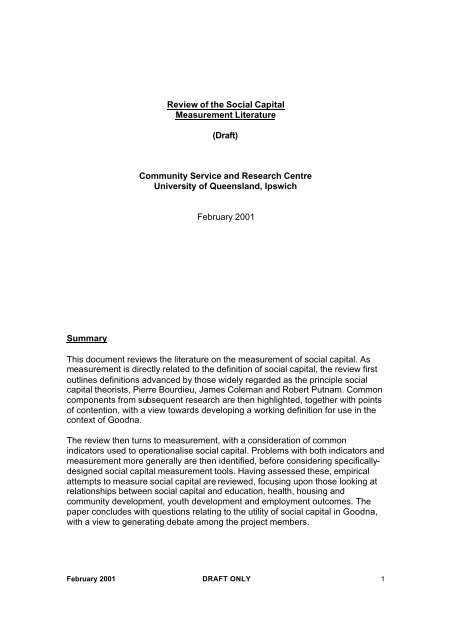

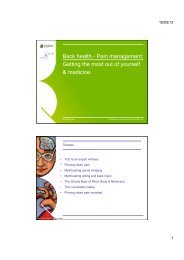
![Recycling [ PDF, 62KB ] - University of Queensland](https://img.yumpu.com/51805185/1/184x260/recycling-pdf-62kb-university-of-queensland.jpg?quality=85)
